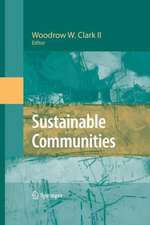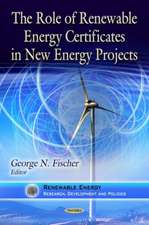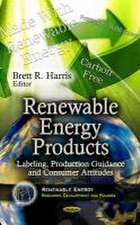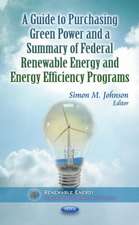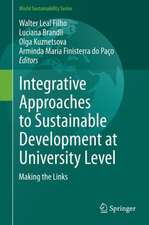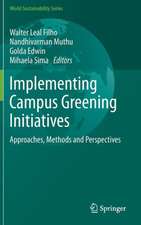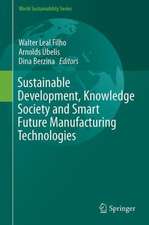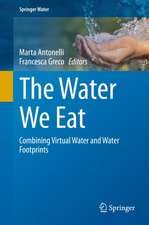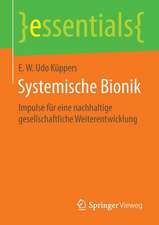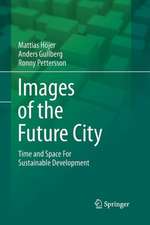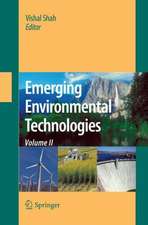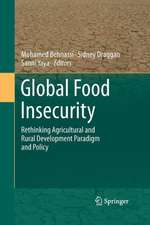The Environmental Management of Low-Grade Fuels: Energy and Infrastructure Set
Autor Mary MacDonald, Michael Chadwick, Gareg Aslanianen Limba Engleză Hardback – oct 2009
In this report, researchers from the Stockholm Environment Institute explore the issues raised by the use of low-grade fuels such as peat, wood, biomass, lignite, oil shale and municipal and industrial wastes. The present strategies and policy options for all stages of the process, from mining and transport to processing and combustion.
With those who would like to learn more about these fuels in mind, the material is presented clearly, and discussions of environmental protection measures are given in table form throughout the ease of reference. A directory of environmental guidelines, regulations and standards is given in an appendix. While a high calorific value fuels remain the most significant source of energy in many countries, economic and other constraints on the use of these fuels may result in more nations turning to low-grade sources of energy to operate their industrial or transportation sectors. The greater potential for environmental degradation that accompanies the use of low-grade fuels means that it is crucial that environmentally sound methods for their management, such as those presented here, be more widely available. The Environmental Management of Low-Grade Fuels will be valuable for industry specialists, policy makers, students and all who are concerned with the life cycle of these materials. Mary MacDonald is an affiliated scientist, and Michael Chadwick is a former director, at the Stockholm Environment Institute. Garegin Aslanian is a senior associate with the Institute for High Temperature Research in Moscow. Originally published in 1996
| Toate formatele și edițiile | Preț | Express |
|---|---|---|
| Paperback (1) | 190.88 lei 6-8 săpt. | |
| Taylor & Francis – 26 oct 2016 | 190.88 lei 6-8 săpt. | |
| Hardback (1) | 516.87 lei 6-8 săpt. | |
| Taylor & Francis – oct 2009 | 516.87 lei 6-8 săpt. |
Preț: 516.87 lei
Preț vechi: 690.14 lei
-25% Nou
Puncte Express: 775
Preț estimativ în valută:
98.91€ • 102.64$ • 82.68£
98.91€ • 102.64$ • 82.68£
Carte tipărită la comandă
Livrare economică 15-29 martie
Preluare comenzi: 021 569.72.76
Specificații
ISBN-13: 9781844079773
ISBN-10: 1844079775
Pagini: 300
Dimensiuni: 156 x 234 x 23 mm
Greutate: 0.64 kg
Ediția:1
Editura: Taylor & Francis
Colecția Routledge
Seria Energy and Infrastructure Set
Locul publicării:Oxford, United Kingdom
ISBN-10: 1844079775
Pagini: 300
Dimensiuni: 156 x 234 x 23 mm
Greutate: 0.64 kg
Ediția:1
Editura: Taylor & Francis
Colecția Routledge
Seria Energy and Infrastructure Set
Locul publicării:Oxford, United Kingdom
Cuprins
Table of ContentsList of Figures and TablesPrefaceAcknowledgementsForewordChapter 1OverviewA definition of Low-grade FuelsFactors Contributing to Calorific ValueEnvironmental Implications of Calorific ValueLow-grade Fuels ConsideredCharacteristics of Low-grade FuelsPeatCoalOil ShaleWoodBiomass other than WoodMunicipal Solid WasteGlobal Use of Low-grade FuelsPeatLigniteOil ShaleWoodBiomass other than WoodDifferences in Low-grade Fuel Use between Developed and Developing CountriesWoodLignitePeatOil ShaleCurrent Application of Low-grade FuelsCombustionGasificationLiquefactionEnvironmental Impacts of Low-grade Fuel UseThe Fuel CycleScale of OperationEnvironmental StandardsConservationTechnology TransferEnvironmental Impacts Associated with IndividualLow-grade FuelsChapter 2Alternative Uses of Low-grade FuelsChemical FeedstocksChemical Products from PeatChemical Feedstocks from LigniteChemical Feedstocks from Oil ShaleChemical Products from WoodThe Environmental Impacts Associated with the Production of Chemical Feedstocks from Low-grade FuelsMining or Gaining for Chemical Feedstock ProductionTransportationHeating and CoolingExtractionWastewater TreatmentFertilizers and Soil Amendments from Low-grade FuelsSphagnum Peat Moss and Peat-derived FertilizersNerosineLiming with Powdered Oil Shale AshGypsumAbsorbent BiofiltersBuilding MaterialsLandfillChapter 3Global Resources and Reserves of Low-grade FuelsLow-grade CoalsPeatOil ShaleWoodBiomass other than WoodMunicipal, Industrial and Mining WastesChapter 4Environmental Management during the Mining of Low-grade FuelsMining of LigniteDestruction of Ground CoverWorker Health and SafetySocial Impacts of Lignite MiningWater Quality and Soil FertilityInteraction with GroundwaterSite RestorationOil Shale MiningAcidic Run-offLand RestorationWorker Health and Safety during Oil Shale MiningSocial Impacts of Oil Shale MiningHarvesting of PeatImpacts on the Physical Environment due to Peat HarvestingWorker Health and Safety during Peat HarvestSocial Impacts of Peat HarvestingHarvesting or Collecting of WoodImpacts to the Physical Environment due to Harvesting of WoodCollection of Biomass other than WoodMunicipal, Industrial and Mining WastesChapter 5Environmental Management of the Transport of Low-grade FuelsEnvironmental Impacts and Low-grade Fuel TransportStorage of Low-grade FuelsImpacts to the Physical Environment due to the Transport of Low-grade FuelsDisruption to Residents along Transport RoutesHealth Risks of Low-grade Fuel TransportWorker Health and Safety during Low-grade Fuel TransportChapter 6Environmental Management During Processing and Upgrading of Low-grade FuelsPeat ProcessingPeat Drying and DewateringCarbonizationCompactionLignite UpgradingHomogenizationCleaningMoisture Removal and Thermal UpgradingDrying and Thermal UpgradingBriquettingEnvironmental Implications of Lignite Processing and UpgradingOil Shale Processing and UpgradingSurface RetortingIn Situ RetortingShale Oil UpgradingWater QualityEnvironmental Management During Oil ShaleProcessing and UpgradingWood ProcessingLarge-scale Charcoal MakingMobility of Carbonization TechnologyEnvironmental Impacts of Charcoal ManufactureBriquetting of Biomass, Municipal Waste and Mining WasteTreatment and Processing of Liquid WastesChapter 7Environmental Management and Low-grade Fuel ConversionLow-grade Fuel Conversion TechnologiesStoves for Domestic Use of Low-grade FuelsFixed Bed CombustionFluidized Bed CombustionCirculating Fluidized Bed CombustionPressurized Fluidized Bed CombustionLow-grade Fuel GasificationIntegrated Gasification Combined CycleFuel PyrolysisOn Overview of Pollutant Formation and ControlHealth Risks of Low-grade Fuel CombustionParticulatesEnvironmental Aspects of ParticulatesControl of Particulate MatterCarbon DioxideEnvironmental Aspects of CO2Environmental Protection and CO2C02 Production and Low-grade FuelsSulphur OxidesEnvironmental Aspects of SOxControl Mechanisms for SOxSOx Production and Low-grade FuelsSulphur Recovery using Wet ProcessesDry alkali Injection into the Combustion ChamberDry AbsorptionUse of Metal OxidesRegenerable ProcessesNitrogen OxidesEnvironmental Aspects of NOxControl Mechanisms for NOxNOx and Low-grade FuelsSuppression of NOx during CombustionFlue Gas Treatment for NOx RemovalHalogensEnvironmental Aspects of HalogensControl of Halogens during CombustionHalogens and Low-grade FuelsPolycyclic Aromatic HydrocarbonsEnvironmental Aspects of PAHsControl of PAHsLow-grade Fuels and PAHsSolid WastesEnvironmental Aspects of Solid WasteEnvironmental Protection Measures for Solid WastesSolid Waste and Low-grade FuelsGaseous Trace ElementsChapter 8Low-grade Fuel Use Efficiency and ConservationEnergy ConservationDeveloping a Conservation PlanEnergy-efficient Power Production and Low-grade FuelsEnergy Process ImprovementBoiler ImprovementInvestment in a New Energy SystemWaste Heat RecoveryChapter 9The Transfer of Environmentally Sound Technology for Low-grade Fuel UseTowards a Definition of Technology TransferControversy Surrounding Technology TransferNew and Expensive versus Older and CheaperThe Social Impacts of TechnologyIndigenous TechnologyEffective Technology TransferMethods and Mechanisms of Technology TransferConstraints to Technology TransferApproaches to Environmentally Sound Technology TransferBusiness Transaction between CompaniesAid Agency FundingEnforcement of Global StandardsReal CostingTrust FundsChapter 10Costs Considerations and Low-grade Fuel UseIndustry or Internal CostsExternal CostsEnvironmental LoadsHealth CostsCosts of Control TechnologyTechnology Cost EstimatesCost Estimation MethodologyOther Methodological ApproachesPollution Abatement OptionsChapter 11Integrated Planning and Environmental Management of Low-grade FuelsIntegrated Energy PlanningEnvironmental Impacts and Integrated Energy PlanningEnergy Sector Indicators of Environmental QualityEnergy IntensityEnvironmental Impact AssessmentConducting on EIAComparing AlternativesModelling ApproachesAppendix AEnvironmental Legislation for Low-grade FuelsEnvironmental PolicyGuidelines, Regulations and StandardsEnvironmental GuidelinesRegulationsStandardsLow-grade Fuel RegulationsGlossaryIndex
Notă biografică
Mary MacDonald, Michael Chadwick, Gareg Aslanian















